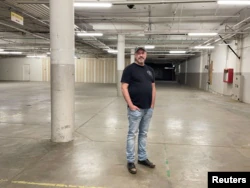America’s largest warehouse market is full as major U.S. retailers warn of slowing sales of the clothing, electronics, furniture and other goods that have packed the distribution centers east of Los Angeles.
The merchandise keeps flooding in from across the Pacific, and for one of the busiest U.S. warehouse complexes, things are about to get worse.
Experts have warned the U.S. supply chain would get hit by the “bullwhip effect” if companies panic-ordered goods to keep shelves full and got caught out by a downturn in demand while shipments were still arriving from Asia.
In the largest U.S. warehouse and distribution market — stretching east from Los Angeles to the area known as the “Inland Empire” — that moment appears to have arrived.
“We’re feeling the sting of the bullwhip,” said Alan Amling, a supply-chain professor at the University of Tennessee.
The sprawl of Inland Empire warehouses centered in Riverside and San Bernardino counties grew quickly in recent years to handle surging demand and goods imported from Asia.
That booming area, visible from space, anchors an industrial corridor encompassing 1.6 billion square feet of storage space that extends from the busiest U.S. seaport in Los Angeles to near the Arizona and Nevada borders. That much storage space is nearly 44 times larger than New York City’s Central Park and 160 times bigger than Tesla Inc’s TSLA.O new Gigafactory in Texas.
But a consumer spending pullback now threatens to swamp warehouses here and around the country with more goods than they can handle — worsening supply — chain snarls that have stoked inflation. Retailers left holding unwanted goods are faced with the choice of paying more money to store them or denting profits by selling them at discount.
Inland Empire warehouse vacancies are among the lowest in the nation, running at a record 0.6% versus the national average of 3.1%, according to real estate services firm Cushman & Wakefield.
The market is poised to get even tighter as shoppers at Walmart WMT.N, Best Buy BBY.N and other retailers retreat from early COVID-era spending binges.
Binge to backlog
While U.S. consumer spending remains above pre-pandemic levels, retailers and suppliers are raising alarms about backlogs in categories that have fallen out of fashion as consumers catch up on travel and struggle with the highest inflation in 40 years.
Last week, Walmart said surging food and fuel prices left its lower-income customers with less cash to spend on goods, and Best Buy said shoppers were curbing spending on discretionary products like computers and televisions. Those cautionary signals followed Target Corp’s TGT.N alert that it was saddled with too many TVs, kitchen appliances, furniture and clothes.
Suppliers — ranging from barbecue grill maker Weber Inc WEBR.N to Helen of Troy Ltd HELE.O, a consumer brands conglomerate that includes OXO kitchen tools — also have warned of slowing demand and an urgent need to clear inventories.
While the U.S. economy was downshifting, goods kept pouring in at near-record levels.
Imports to U.S. container ports that process retail goods from China and other countries jumped more than 26% in the first half of 2022 from pre-pandemic levels, according to Descartes Datamyne. Christmas shipments and the reopening of major Chinese factory hubs could goose volumes further.
Meanwhile, cargo keeps flooding in to the busiest U.S. seaport complex at Los Angeles/Long Beach. During the first half of this year, dockworkers there handled about 550,000 more 40-foot containers than before the pandemic started, according to port data.
Christmas toys and winter holiday decor landed on those docks in July, along with some patio furniture for Walmart and stretch pants, jeans and shoes for Target, said Steve Ferreira, CEO of Ocean Audit, which scrutinizes marine shipping invoices.
Retailers ordered most of those goods months ago and many are destined for the Inland Empire’s already jam-packed warehouses.
“It’s a domino effect. Now the inventory is going to really build up,” said Scott Weiss, a vice president at Performance Team, a Maersk MAERSKb.CO company with 22 warehouses in greater Los Angeles.
Demand for space in the Inland Empire is so intense that when 100,000 to 200,000 square feet of space frees up, it “gets gobbled up in a second,” said Weiss.
Sears and parking lots
Investors have almost 40 million square feet under construction in the Inland Empire — including Amazon.com Inc’s AMZN.O biggest-ever warehouse — and at least 38% is spoken for, said Dain Fedora, vice president of research for Southern California at Newmark, a commercial real estate advisory firm.
While Amazon’s 4.1 million square-foot facility rises on former dairy land in the city of Ontario, the online retailer has been shelving construction plans in other parts of the country.
Amazon is the biggest warehouse tenant in the Inland Empire and the nation. Its decision to scale back on building, coupled with rising interest rates and the slowing economy, is sidelining other would-be Inland Empire warehouse builders, area real estate brokers and economists told Reuters.
Meanwhile, the scramble for space continues.
Trucking company yards and spare lots around the region have already been converted to makeshift container storage, so entrepreneurs are marketing vacant stores as last-resort warehouses in waiting.
Brad Wright is CEO of Chunker, which bills itself as an AirBNB for warehouses, and works with everyone from state officials to the owners of vacated big-box stores to find new places to stash goods.
During a recent tour at the former Sears anchor store in San Bernardino’s Inland Center mall, Wright and a potential tenant strolled past collapsed ceiling tiles, sagging wall panels and idled escalators while working out how forklifts would navigate the abandoned space. Wright sees the empty stores as one answer to easing the log jams.
“There’s a lot of them sitting around, and they’re in good locations,” he said.

